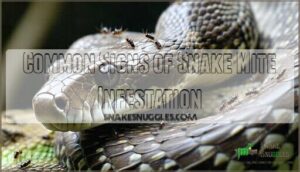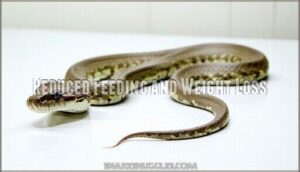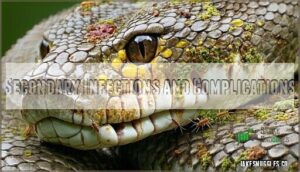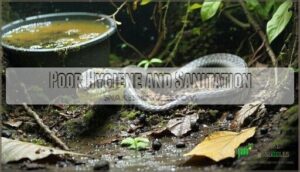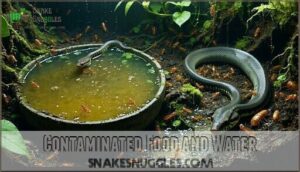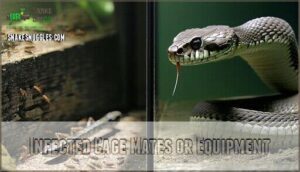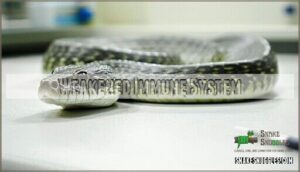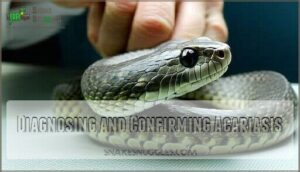This site is supported by our readers. We may earn a commission, at no cost to you, if you purchase through links.
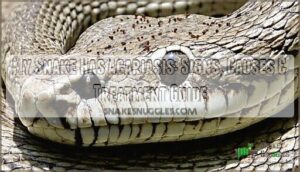
These tiny parasites cause intense itching, leading to excessive rubbing, abnormal shedding, and behavioral changes like soaking in water more often.
You’ll notice your snake becoming restless, possibly losing appetite, and developing skin lesions.
Don’t panic – acariasis is treatable with proper veterinary care, medication, and thorough habitat cleaning.
The key is acting quickly before secondary infections set in.
Your snake’s constant scratching isn’t just annoying behavior; it’s a cry for help that requires immediate attention and the right treatment approach.
Table Of Contents
- Key Takeaways
- Recognizing Acariasis Symptoms
- Causes and Risk Factors of Acariasis
- Diagnosing and Confirming Acariasis
- Treating and Managing Acariasis
- Preventing Future Acariasis Infections
- Frequently Asked Questions (FAQs)
- How is acariasis diagnosed?
- How do you know if you have a acariasis?
- Can a snake mite cause a rash?
- What is cryptosporidiosis & how does it affect snakes?
- Are Constrictor-type snakes contagious?
- How do you know if a snake has a parasite?
- How to know if a snake has parasites?
- What is the lifespan of a snake mite?
- How long does it take to get rid of acariasis?
- Can acariasis be transmitted to other pets or humans?
- Conclusion
Key Takeaways
- Act quickly when you spot the signs – Look for tiny black dots moving on your snake’s skin, excessive scratching, abnormal shedding, and reduced appetite, as early detection prevents serious complications and secondary infections.
- Get professional veterinary care immediately – Don’t attempt to treat acariasis yourself; your vet will provide proper medications like ivermectin and create a treatment plan that’s safe and effective for your snake’s specific situation.
- Clean everything thoroughly and repeatedly – Discard all substrate, disinfect the entire enclosure with reptile-safe cleaners, and maintain strict hygiene during treatment to break the mite life cycle completely.
- Prevent future infestations through proper husbandry – Quarantine new snakes for 60-90 days, maintain weekly cleaning schedules, replace water regularly, and choose reputable breeders to avoid bringing mites into your collection.
Recognizing Acariasis Symptoms
If you suspect your snake has acariasis, you’ll need to recognize the telltale signs quickly to start treatment.
The symptoms can range from subtle behavioral changes to obvious physical indicators that something’s wrong with your pet, which requires immediate attention to treatment.
Common Signs of Snake Mite Infestation
When your snake starts acting like it’s got the itches, mite identification becomes essential.
When your snake can’t stop scratching, mites are making their move.
You’ll spot tiny black dots crawling on scales – that’s your first red flag. Snake behavior changes dramatically: restlessness, excessive rubbing against cage walls, and skin irritation become obvious.
Acariasis symptoms include visible mites moving around, ash-like "dust" on scales, and infestation signs like reduced feeding.
These reptile mites cause serious discomfort, making early detection essential for your snake’s wellbeing.
Abnormal Shedding and Skin Lesions
Your snake’s shedding patterns can reveal hidden problems. When acariasis strikes, you’ll notice patchy, incomplete sheds instead of clean, one-piece molts. Scale damage from mite bites creates rough, discolored patches that won’t heal properly.
Watch for these warning signs:
- Frequent shedding attempts with retained pieces
- Red, inflamed areas with visible skin irritation
- Crusty lesions that worsen without lesion treatment
Abnormal shedding isn’t just cosmetic—it signals your snake’s struggling with mite infestation stress.
Reduced Feeding and Weight Loss
When your snake suddenly stops eating or starts losing weight, it’s time to pay attention.
When appetite disappears and weight drops, your snake is sending an urgent SOS signal.
Appetite loss and weight decline are red flags for snake acariasis that many owners miss.
Feeding issues develop as mites stress your pet and drain their energy.
This snake malnutrition weakens their immune system, creating a dangerous cycle.
Starvation risks increase if left untreated, so monitor your snake’s eating habits closely and weigh them regularly.
Severe Itchiness and Restlessness
When you see your snake frantically rubbing against enclosure walls, you’re witnessing snake acariasis in action. Mite bites cause intense skin irritation, making your pet desperate for itch relief. This restlessness signals severe discomfort from mite infestation.
Restlessness causes include:
- Constant scratching against rough surfaces
- Rapid body movements and coiling
- Inability to settle or rest peacefully
- Excessive soaking attempts for relief
Recognizing parasite infection signs is essential for effective treatment. Snake comfort depends on prompt acariasis treatment to stop this torture.
Secondary Infections and Complications
When your snake’s relentless scratching breaks skin, you’re facing a double threat.
Open wounds become gateways for dangerous complications that can turn deadly fast.
- Bacterial Infections – Raw scratches invite harmful bacteria, causing skin ulcers and systemic infections
- Fungal Diseases – Warm, humid conditions perfect for fungal growth in damaged tissue
- Respiratory Issues – Mites invading nasal passages create breathing problems requiring immediate snake mite treatment
Your snake’s weakened immune system can’t fight these secondary infections effectively, making swift action critical.
Causes and Risk Factors of Acariasis
Understanding what causes snake mites helps you protect your pet from future infestations.
Your snake’s environment, health status, and exposure to contaminated sources all play key roles in determining mite risk.
Poor Hygiene and Sanitation
In the context of snake hygiene, your cleaning habits directly impact your pet’s health.
Poor Enclosure Cleaning creates the perfect Mite Habitat where snake mites thrive and multiply rapidly.
| Hygiene Factor | Impact on Snake Health |
|---|---|
| Substrate Choice | Old bedding harbors mite eggs |
| Water Quality | Stagnant water attracts parasites |
| Waste Removal | Feces creates breeding grounds |
| Cage Cleaning | Dirty surfaces support infestations |
Your snake enclosure hygiene matters more than you think—facilities with poor sanitation see 72.7% mite infestations compared to 38.3% in clean environments.
Owners might first notice them as black parasites in their snake’s water bowl.
Contaminated Food and Water
Contaminated prey and water sources create perfect breeding grounds for snake mites and other parasites.
Your snake’s nutrition directly impacts its vulnerability to these pests through Source Contamination. Cottonmouths, for example, possess venom containing tissue damaging enzymes.
- Store frozen prey properly and thaw safely using Hygiene Protocols
- Replace water bowls weekly to prevent Waterborne Mites from establishing colonies
- Wash hands before handling food to avoid introducing Foodborne Vectors
- Implement Prevention Strategies by sourcing prey from reputable suppliers only
Infected Cage Mates or Equipment
Cross-contamination happens when mite transmission occurs between snakes or through shared equipment.
That borrowed hide box or water dish could harbor invisible hitchhikers. Shared enclosures create perfect conditions for mites to jump ship.
Always implement strict quarantine protocols and thorough equipment sanitation before introducing new items.
Environmental cleaning prevents cross-contamination nightmares.
Weakened Immune System
Your snake’s weakened immune system opens the door for mite infestation. When their defenses are down, these tiny parasites can easily take hold and multiply.
Several factors compromise your snake’s immunity:
- Stress Impact from poor housing conditions or handling
- Nutritional Deficiencies from inadequate diet or feeding schedules
- Age Factors affecting older or very young snakes
- Underlying Diseases that drain the immune system
- Genetic Predisposition in certain breeds
A compromised immune system can’t fight off snake parasites effectively, making mite infestation more likely and severe. Regular check-ups can help detect intestinal and skin parasites early.
Genetics and Breed Predisposition
Behind your snake’s vulnerability to mites lies a genetic blueprint that can’t be ignored. Some breeds carry genetic resistance while others face breed susceptibility through no fault of their own. Heritability factors passed down from parents influence how well your snake fights off these tiny invaders.
- Ball pythons and corn snakes show higher susceptibility rates
- Selective breeding programs can reduce mite vulnerability over generations
- Hybrid vigor sometimes creates stronger resistance in crossbred snakes
- Snake genetics determine immune response strength against snake mites
Understanding your snake’s genetic background helps you stay one step ahead of potential infestations.
Diagnosing and Confirming Acariasis
Once you suspect your snake has acariasis, you’ll need to confirm the diagnosis through careful examination and testing.
Visual inspection alone isn’t always enough—proper identification requires looking for specific signs and sometimes getting professional help to rule out other conditions.
Visual Inspection and Examination
Now you’re ready to play detective with your snake. Start by examining your pet closely for mite identification – look for tiny black or red dots crawling on the scales.
Check shed skin for mite infestation signs like small dark specks or ash-like residue.
| What to Look For | Where to Check |
|---|---|
| Moving black/red dots | Snake’s body and head |
| Ash-like "mite dust" | Shed skin and scales |
| Skin lesions or irritation | Around eyes and mouth |
Don’t forget enclosure examination – inspect water bowls, hiding spots, and cage walls for mites.
Behavioral clues like excessive rubbing or restlessness often signal trouble before you spot the actual pests.
Laboratory Testing and Microscopy
When your vet suspects acariasis, they’ll use microscopy techniques and sample collection methods to confirm the diagnosis.
Mite identification involves examining skin scrapings, tape impressions, or water bowl samples under a microscope.
Your vet will look for adult mites, egg detection, and fecal analysis showing that telltale ash-colored debris.
These mite diagnostic tests help identify the specific mite species causing trouble, ensuring you get the right treatment for your snake’s particular situation.
Differential Diagnosis and Rule-Outs
While symptoms might seem straightforward, other conditions can mimic snake mites and throw you off track.
Don’t jump to conclusions without ruling out these sneaky culprits:
- Skin Infections – Bacterial or fungal infections create similar skin lesions and abnormal shedding patterns that fool even experienced keepers
- Stress Factors – Environmental changes trigger symptoms identical to mite diagnosis, including reduced appetite and restless behavior
- Nutritional Deficiencies – Poor diet causes snake symptoms like skin problems and weight loss that mirror ectoparasites
Environmental dermatitis and other ectoparasites also complicate diagnosis, making professional evaluation essential for accurate identification.
Importance of Veterinary Consultation
Once you’ve identified potential mites, veterinary consultation becomes your next smart move.
A reptile veterinarian provides expert diagnosis through proper testing and can rule out underlying conditions that mimic mite symptoms.
They’ll recommend safe treatment options and create preventative care plans for your snake’s long-term health, ensuring you’re not guessing with your pet’s wellbeing.
Stages of Acariasis and Disease Progression
Understanding acariasis progression helps you act fast. Initial Infestation starts with just a few snake mites that quickly multiply.
Mite Reproduction explodes within days, creating visible clusters on your snake’s scales. A key aspect is understanding mite lifecycle stages, as this knowledge aids in targeted treatment.
Systemic Effects emerge as blood loss weakens your pet, causing lethargy and poor appetite.
Advanced Acariasis brings severe skin lesions and secondary infections. Without treatment, Long-Term Damage includes permanent scarring and compromised immunity.
Treating and Managing Acariasis
Once you’ve confirmed your snake has acariasis, you’ll need to act fast with both medical treatment and environmental management.
The good news is that with the right approach, you can eliminate these pesky mites and get your snake back to full health.
You should consider medical treatment as part of your approach to help your snake recover.
Medications and Topical Treatments
When treating snake acariasis, ivermectin and permethrin are your go-to medications.
These acaricide products pack a punch against mites, but dosage calculation is vital—too much can harm your snake. Topical treatments like Frontline spray offer targeted application methods.
Some cases need combination therapies for treatment resistance. For those seeking to purchase these treatments, consider ivermectin options.
Always follow reptile medicine guidelines and consult your vet for proper acaricide safety protocols.
Environmental Cleaning and Disinfection
Environmental cleaning isn’t just about looking good—it’s your secret weapon against mite comeback tours.
After treating your snake, you’ll need to wage war on every surface those tiny invaders touched.
Here’s your battle plan for mite-proof barriers and thorough sanitation:
- Discard all substrate immediately—no exceptions, even if it looks clean
- Soak enclosure materials in hot water with safe disinfectants like diluted bleach
- Clean reptile enclosures weekly using mite control products designed for herps
- Replace porous items like wooden hides that can harbor microscopic hitchhikers
- Establish cleaning frequency of deep sanitization every few days during treatment
This environmental cleaning routine breaks the mite life cycle completely.
Effective reptile mite control is essential for prevention.
Improving Hygiene and Husbandry Practices
Once you’ve tackled environmental cleaning, your next move is upgrading your husbandry practices. Think of it as giving your snake a five-star hotel experience instead of a sketchy motel room.
Here’s your action plan:
- Enclosure Sanitation: Clean weekly, removing waste immediately and disinfecting surfaces with reptile-safe cleaners.
- Substrate Selection: Choose paper towels or reptile carpet over loose substrates that harbor mites and bacteria.
- Water Quality: Replace water every 3-4 days using dechlorinated water, scrubbing the bowl thoroughly.
- Handling Practices: Wash hands before and after contact, handle infected snakes last to prevent cross-contamination.
These improvements create an environment where mites can’t thrive, supporting your snake’s recovery.
Nutritional Support and Supplements
Your snake’s body needs proper fuel to fight off acariasis effectively.
A balanced diet with high-quality prey items supports recovery and boosts immune function.
Focus on hydration importance – provide fresh water daily since dehydrated snakes struggle more with infections.
Appetite stimulation may be necessary if your snake won’t eat; try warming prey slightly or offering smaller portions.
Supplement types like vitamin A can support gut health, but don’t overdo it.
Nutritional support speeds snake recovery naturally.
Follow-Up Care and Monitoring
Recovery doesn’t end when treatments stop. Your snake’s healing journey requires ongoing vigilance and care to guarantee complete recovery and prevent future problems.
After completing initial treatment, you’ll need to maintain consistent monitoring to catch any signs of recurrence prevention failure or emerging complications.
Regular check-ups with your vet help track your snake’s progress and adjust husbandry practices as needed. Watch for appetite changes, altered shedding patterns, and incomplete lesion healing. These indicators tell you how well your snake recovery is progressing.
Keep detailed records of your observations:
- Daily appetite monitoring – noting feeding responses and food acceptance rates
- Weekly weight checks – tracking gradual weight gain and overall body condition
- Shedding cycle documentation – watching for normal, complete sheds without retained pieces
- Hydration levels assessment – observing skin elasticity and overall moisture content
Maintain strict cage cleaning schedules and quarantine procedures. Your vet will guide you on when it’s safe to resume normal handling routines and housing arrangements after confirming your snake’s full recovery through veterinary checkups.
Preventing Future Acariasis Infections
Once you’ve successfully treated your snake’s acariasis, preventing future outbreaks becomes your top priority to keep your scaly friend healthy and comfortable.
The good news is that with proper care and attention to detail, you can create an environment where mites simply can’t thrive.
Best Practices for Cage Cleaning and Maintenance
Your snake’s health depends on consistent cage cleaning and proper husbandry practices.
Clean weekly and change substrate every two weeks to prevent mite infestations. Remove waste immediately and maintain water quality through regular changes.
Disinfect all cage furnishings with reptile-safe solutions. Choose non-porous materials for easy sanitation and effective mite prevention.
Many owners find success with a dedicated cage cleaner.
Cage Cleaning Frequency Why It Matters
Quarantine and Isolation Procedures
Beyond routine cleaning, proper quarantine procedures act as your first line of defense against mite outbreaks.
Set up a separate isolation setup for new arrivals, maintaining them for 60-90 days in simplified enclosures with easy-to-inspect substrates.
This quarantine duration allows you to monitor protocols effectively while preventing cross-contamination.
Mite-proofing your quarantine area means using escape-proof containers and handling infected animals last to isolate potential threats from your main collection.
Regular Veterinary Check-Ups and Screenings
Early detection through routine veterinary care is your snake’s best defense against acariasis and other reptile health issues.
Regular screenings establish health baselines and catch problems before they become serious.
Here’s how preventative care protects your snake:
- Annual exams include physical checks, weight monitoring, and parasite monitoring to spot mites early
- Diagnostic testing uses microscopy and blood work to confirm infestations and rule out other snake diseases
- Expert advice on husbandry improvements helps prevent future reptile care problems
Professional veterinary care guarantees proper treatment and faster recovery.
Breeder and Pet Store Precautions
While regular check-ups keep your snake healthy, choosing the right source reptiles from the start prevents mite headaches altogether.
When shopping for your scaly friend, don’t just fall for the first cute face you see. Smart buyers investigate before they buy.
Research potential breeders thoroughly, asking about their quarantine protocols and mite screening procedures. Visit facilities to observe hygiene standards firsthand – clean enclosures and healthy animals speak volumes about ethical practices.
Reputable sources will welcome your questions about acariasis prevention and mite prevention measures.
- Red flag alert: Avoid sellers who can’t discuss their sanitation methods or seem evasive about health histories.
Quality breeders maintain strict quarantine systems and practice ethical sourcing, ensuring you won’t inherit someone else’s mite problem.
Owner Education and Awareness
Knowledge is your best defense against snake mites.
You can’t prevent what you don’t understand, so let’s bust some common myths:
Mite Prevention Myths Reality Check
Master mite identification, understand quarantine importance, and practice safe handling.
Preventing infestations requires consistent cleaning routines.
Your snake’s health depends on solid husbandry practices and recognizing snake mites symptoms early.
Frequently Asked Questions (FAQs)
How is acariasis diagnosed?
Don’t get caught off guard—diagnosing acariasis involves spotting tiny moving dots on your snake’s skin.
Checking for ash-like dust on scales, and watching for behavioral changes like excessive scratching and restlessness are also crucial steps in the diagnosis process, as they can indicate the presence of acariasis.
How do you know if you have a acariasis?
You’ll spot tiny black dots moving on your snake’s skin or shed, plus ash-like "dust" on scales. Your snake might scratch excessively, eat less, and show abnormal shedding patterns.
Can a snake mite cause a rash?
Like tiny vampires on the prowl, snake mites can indeed cause a rash in humans.
You’ll notice red, itchy bumps where they’ve bitten you, typically on your hands and arms after handling infected snakes.
What is cryptosporidiosis & how does it affect snakes?
Cryptosporidiosis is a parasitic infection caused by Cryptosporidium serpentis that affects your snake’s digestive system. It causes chronic diarrhea, weight loss, regurgitation, and can be fatal if untreated.
Are Constrictor-type snakes contagious?
Constrictor snakes aren’t inherently contagious, but they can spread mites and parasites like acariasis through direct contact or shared environments. You’ll need to quarantine affected snakes immediately.
How do you know if a snake has a parasite?
Devastatingly, parasites can wreak havoc on your snake’s health! You’ll spot tiny moving dots, abnormal shedding, skin lesions, reduced appetite, and restless behavior indicating mite infestations or other parasitic issues.
How to know if a snake has parasites?
Check your snake’s skin for tiny black dots, white "dust" on scales, excessive scratching, abnormal shedding, reduced appetite, and visible mites crawling on the snake or enclosure walls.
What is the lifespan of a snake mite?
Snake mites typically live 40-45 days, completing their entire life cycle in about two weeks under ideal conditions.
They’ll reproduce rapidly in warm, humid environments, so you’ll need to act quickly to break their breeding cycle.
How long does it take to get rid of acariasis?
Like battling a persistent weed, eliminating acariasis requires patience and consistent effort. With proper treatment and thorough environmental cleaning, you’ll typically see complete elimination within 2-4 weeks of repeated treatments.
Can acariasis be transmitted to other pets or humans?
Snake mites rarely transmit to other pets or humans.
You don’t need to worry about spreading acariasis to dogs, cats, or family members.
These parasites are species-specific and prefer reptilian hosts exclusively.
Conclusion
Successfully treating acariasis requires dedication, persistence, and patience.
You’ll need consistency in medication, cleanliness in husbandry, and vigilance in monitoring. When you notice "my snake has acariasis," don’t delay treatment.
Early intervention prevents complications and reduces recovery time. With proper veterinary care and environmental management, your snake will overcome this uncomfortable condition.
Remember that prevention through good hygiene practices is always easier than treatment, so maintain clean enclosures and quarantine new additions to ensure your snake’s health and well-being, and provide the best chance for a successful recovery with proper care.
- https://reptilenetworks.co.uk/2019/11/24/why-do-you-say-no-to-calcium-sand/
- https://familysnake.com/guides/unraveling-serpent-health-spotting-common-issues-in-pet-snakes/
- https://www.aaha.org/resources/2011-aaha-avma-preventive-healthcare-guidelines/
- https://meridian.allenpress.com/jhms/article/10/3/4/137263/The-Biology-Clinical-Significance-and-Control-of
- https://www.biotaxa.org/pja/article/view/202116

